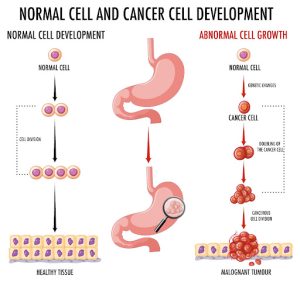Disclaimer:
This article is for information purposes only. It is not a substitute for medical advice or treatment. Seek medical care for your treatment.
What is Lung Cancer?
Cancer is a disease in which cells in the body grow out of control. When cancer begins in the lungs, it is called lung cancer. Lung cancer is a disease caused by uncontrolled cell division in your lungs. Your cells multiply and make more copies as a part of their normal function. Your cells’ regular process involves dividing and creating additional copies of themselves. However, occasionally, they experience mutations that lead them to continue producing more of themselves when they shouldn’t. Uncontrolled cell division caused by damage results in tissue masses known as tumors that eventually impair the functionality of your organs.
Cancers that originate in the lungs are referred to as lung cancers; these are typically found in the alveoli, which are tiny air sacs, or the bronchi or bronchioles. Generally speaking, cancers that originate elsewhere and spread to your lungs are called after their original site of origin (your healthcare provider may refer to this as cancer that is metastatic to your lungs).
Function of normal Lungs:
Lungs are 2 sponge-like organs in the chest. Right lung has 3 sections called lobes. Your left lung has 2 lobes. Left lung is smaller because heart consumes more space on that side of the body. When you inhale, air enters via your mouth or nose and goes into your lungs through trachea. The trachea divides into tubes called bronchi, which enter the lungs and divide into smaller bronchi. Theses divide to make smaller branches called bronchioles. Alveoli are the tiny air sacs located at the end of the bronchioles. When you inhale, the alveoli take in oxygen from the outside air and eliminate carbon dioxide. The chief functions of the lungs are the intake of oxygen and the removal of carbon dioxide.
Usually, lung cancers begin in the cells lining the bronchi and other areas of the lung, such as the alveoli or bronchioles.
What is metastatic lung cancer?
Metastatic lung cancer begins in one lung but spreads to the other lung or other organs. Metastatic cancer is difficult to cure than cancer that has not spread outside of its original location.
How frequent is lung cancer?
Lung cancer is the third most prevalent cancer in the U.S. health systems report more than 200,000 new cases of lung cancer every year.
Types of lung cancer:
There are various cancers that harm the lungs, but generally the term “Lung Cancer” is used for two main kinds, which are enlisted below:
- Non-small cell lung cancer:
It is the most frequent and typical type of lung cancer. More than 80% of cases of lung cancer are linked to it. Squamous cell carcinoma and adenocarcinoma are common varieties. Two less prevalent forms of NSCLC are sarcomatoid carcinoma and adenosquamous carcinoma.
- Small cell lung cancer:
In comparison, non-small cell lung cancer (NSCLC) develops more slowly and is easier to treat. A comparatively small lung tumor that has already spread to other parts of your body is typically how it becomes apparent. Small cell carcinoma, also known as oat cell carcinoma, and combined small cell carcinoma are two specific forms of SCLC.
Other types of lung cancer:
Sarcomas, which are cancers of the soft tissues or bones, lymphomas, which are cancers of the lymph nodes, and pleural mesothelioma, which is cancer of the lining of the lungs, are among the other cancers that start in or near the lungs. These are typically not referred to as lung cancer and are treated differently.
Stages of lung cancer:
Stage of the cancer depends on the size of the initial tumor, how far or deep into the tissues it got and whether it is spread to the lymph nodes or other organs. General staging for lung cancer is:
- Stage 0: cancer is in the top lining of the lung or bronchus. It has not spread to other parts of the lung or outside of the lung.
- Stage I: cancer has not spread outside the lung.
- Stage II: cancer is bigger than stage I and has spread to lymph nodes inside the lung or there is more than one tumor in the same lobe of the lung.
- Stage III: cancer is bigger than stage II and has spread to nearby lymph nodes or structures or there is more than one tumor in a different lobe of the same lung.
- Stage IV: cancer has spread to the other lung, the fluid around the lung, the fluid around the heart or other organs.
Limited and extensive stage:
While doctors now use stages I through IV for small cell lung cancer, you might hear it described as limited or extensive stage. This is based on whether the area can be cured with single radiation field.
- Limited stage SCLC: is limited to one lung and can sometimes be in the lymph nodes in the middle of the chest or above the collar bone on the same side.
- Extensive stage SCLC: is expanded throughout one lung or has grown to the other lung, lymph nodes on the opposite side of the lung or to other parts of the body.
Conclusion:
Lung cancer grows in your lungs and can spread to the other body parts. The prognosis and treatment depends on the type and stage of your cancer. Chemotherapy, surgery and radiation are the treatment of cancer. Patients with lung cancer now have greater probability of survival thanks to recent treatments, and joining a clinical trial may be beneficial if other treatments don’t work.
Although there is no certain way to prevent lung cancer, you can significantly lower your risk of getting the disease by giving up smoking and restricting risky exposures.




